White/Caucasian vs Immigrants from Oceania Community Comparison
COMPARE
White/Caucasian
Immigrants from Oceania
Social Comparison
Social Comparison
Whites/Caucasians
Immigrants from Oceania
5,140
SOCIAL INDEX
48.9/ 100
SOCIAL RATING
185th/ 347
SOCIAL RANK
6,183
SOCIAL INDEX
59.3/ 100
SOCIAL RATING
161st/ 347
SOCIAL RANK
Immigrants from Oceania Integration in White/Caucasian Communities
The statistical analysis conducted on geographies consisting of 305,180,194 people shows a weak negative correlation between the proportion of Immigrants from Oceania within White/Caucasian communities in the United States with a correlation coefficient (R) of -0.277. On average, for every 1% (one percent) increase in Whites/Caucasians within a typical geography, there is a decrease of 0.003% in Immigrants from Oceania. To illustrate, in a geography comprising of 100,000 individuals, a rise of 1,000 Whites/Caucasians corresponds to a decrease of 3.0 Immigrants from Oceania.
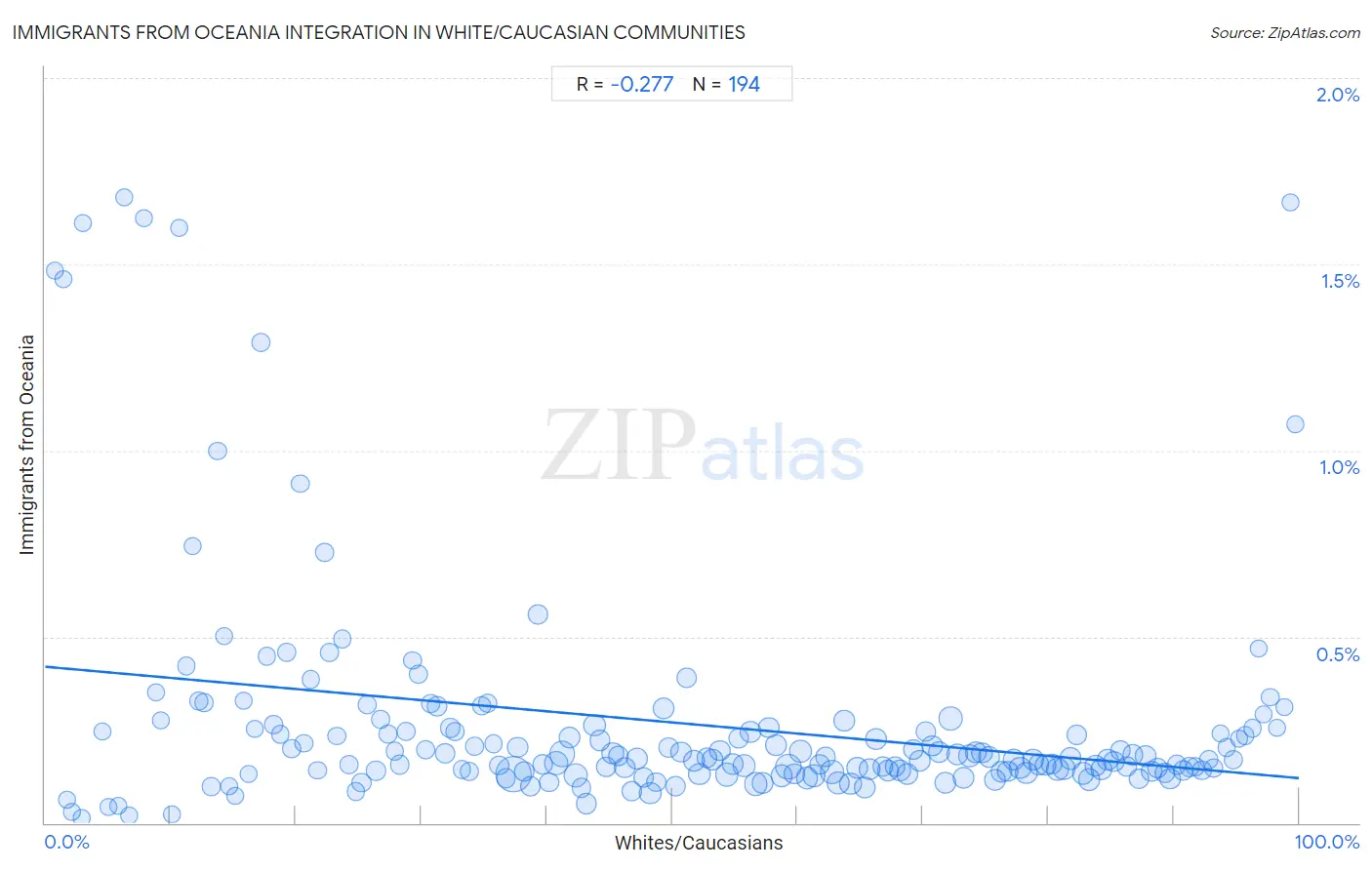
White/Caucasian vs Immigrants from Oceania Income
When considering income, the most significant differences between White/Caucasian and Immigrants from Oceania communities in the United States are seen in wage/income gap (28.5% compared to 25.6%, a difference of 11.2%), householder income over 65 years ($58,847 compared to $64,416, a difference of 9.5%), and median household income ($82,029 compared to $89,100, a difference of 8.6%). Conversely, both communities are more comparable in terms of median male earnings ($53,925 compared to $55,712, a difference of 3.3%), median earnings ($45,197 compared to $47,617, a difference of 5.3%), and householder income ages 45 - 64 years ($98,091 compared to $103,705, a difference of 5.7%).

| Income Metric | White/Caucasian | Immigrants from Oceania |
| Per Capita Income | Poor $42,180 | Excellent $45,220 |
| Median Family Income | Poor $99,800 | Excellent $106,453 |
| Median Household Income | Poor $82,029 | Exceptional $89,100 |
| Median Earnings | Poor $45,197 | Excellent $47,617 |
| Median Male Earnings | Fair $53,925 | Good $55,712 |
| Median Female Earnings | Tragic $37,531 | Good $40,297 |
| Householder Age | Under 25 years | Tragic $50,336 | Exceptional $53,680 |
| Householder Age | 25 - 44 years | Poor $91,668 | Excellent $97,623 |
| Householder Age | 45 - 64 years | Fair $98,091 | Excellent $103,705 |
| Householder Age | Over 65 years | Tragic $58,847 | Exceptional $64,416 |
| Wage/Income Gap | Tragic 28.5% | Average 25.6% |
White/Caucasian vs Immigrants from Oceania Poverty
When considering poverty, the most significant differences between White/Caucasian and Immigrants from Oceania communities in the United States are seen in single father poverty (18.4% compared to 15.4%, a difference of 18.9%), single male poverty (14.5% compared to 12.4%, a difference of 16.8%), and single female poverty (22.7% compared to 20.7%, a difference of 9.9%). Conversely, both communities are more comparable in terms of poverty (12.3% compared to 12.3%, a difference of 0.080%), family poverty (8.8% compared to 8.7%, a difference of 0.34%), and female poverty (13.4% compared to 13.3%, a difference of 0.51%).
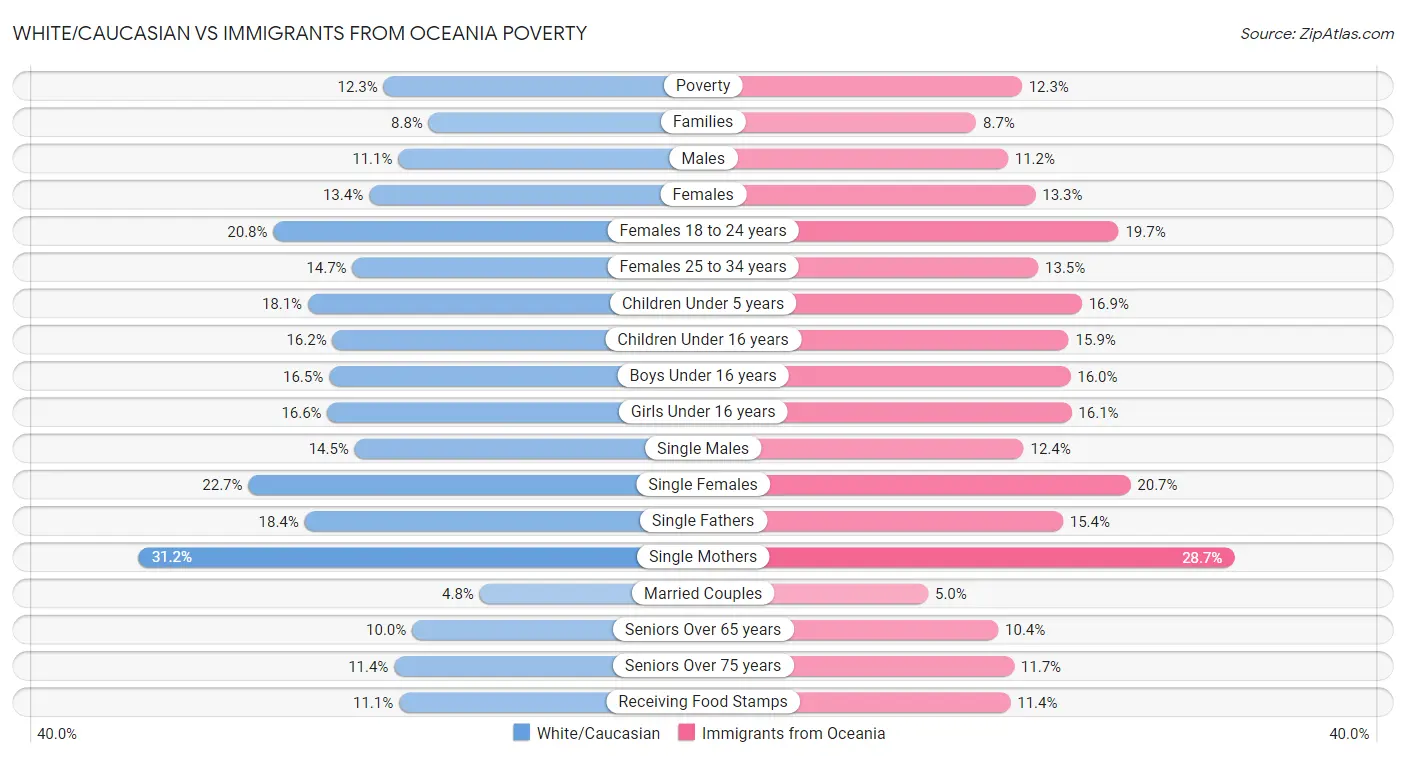
| Poverty Metric | White/Caucasian | Immigrants from Oceania |
| Poverty | Average 12.3% | Average 12.3% |
| Families | Good 8.8% | Good 8.7% |
| Males | Average 11.1% | Average 11.2% |
| Females | Average 13.4% | Average 13.3% |
| Females 18 to 24 years | Tragic 20.8% | Excellent 19.7% |
| Females 25 to 34 years | Tragic 14.7% | Average 13.5% |
| Children Under 5 years | Poor 18.1% | Good 16.9% |
| Children Under 16 years | Average 16.2% | Good 15.9% |
| Boys Under 16 years | Average 16.5% | Good 16.0% |
| Girls Under 16 years | Average 16.6% | Good 16.1% |
| Single Males | Tragic 14.5% | Exceptional 12.4% |
| Single Females | Tragic 22.7% | Good 20.7% |
| Single Fathers | Tragic 18.4% | Exceptional 15.4% |
| Single Mothers | Tragic 31.2% | Good 28.7% |
| Married Couples | Exceptional 4.8% | Good 5.0% |
| Seniors Over 65 years | Exceptional 10.0% | Excellent 10.4% |
| Seniors Over 75 years | Exceptional 11.4% | Excellent 11.7% |
| Receiving Food Stamps | Excellent 11.1% | Good 11.4% |
White/Caucasian vs Immigrants from Oceania Unemployment
When considering unemployment, the most significant differences between White/Caucasian and Immigrants from Oceania communities in the United States are seen in unemployment among women with children ages 6 to 17 years (9.6% compared to 8.1%, a difference of 19.2%), unemployment among seniors over 75 years (10.1% compared to 9.0%, a difference of 12.0%), and unemployment among women with children under 6 years (8.4% compared to 7.5%, a difference of 11.8%). Conversely, both communities are more comparable in terms of unemployment among women with children under 18 years (5.3% compared to 5.3%, a difference of 0.030%), unemployment among ages 55 to 59 years (4.7% compared to 4.7%, a difference of 0.51%), and unemployment among ages 60 to 64 years (4.7% compared to 4.7%, a difference of 0.63%).
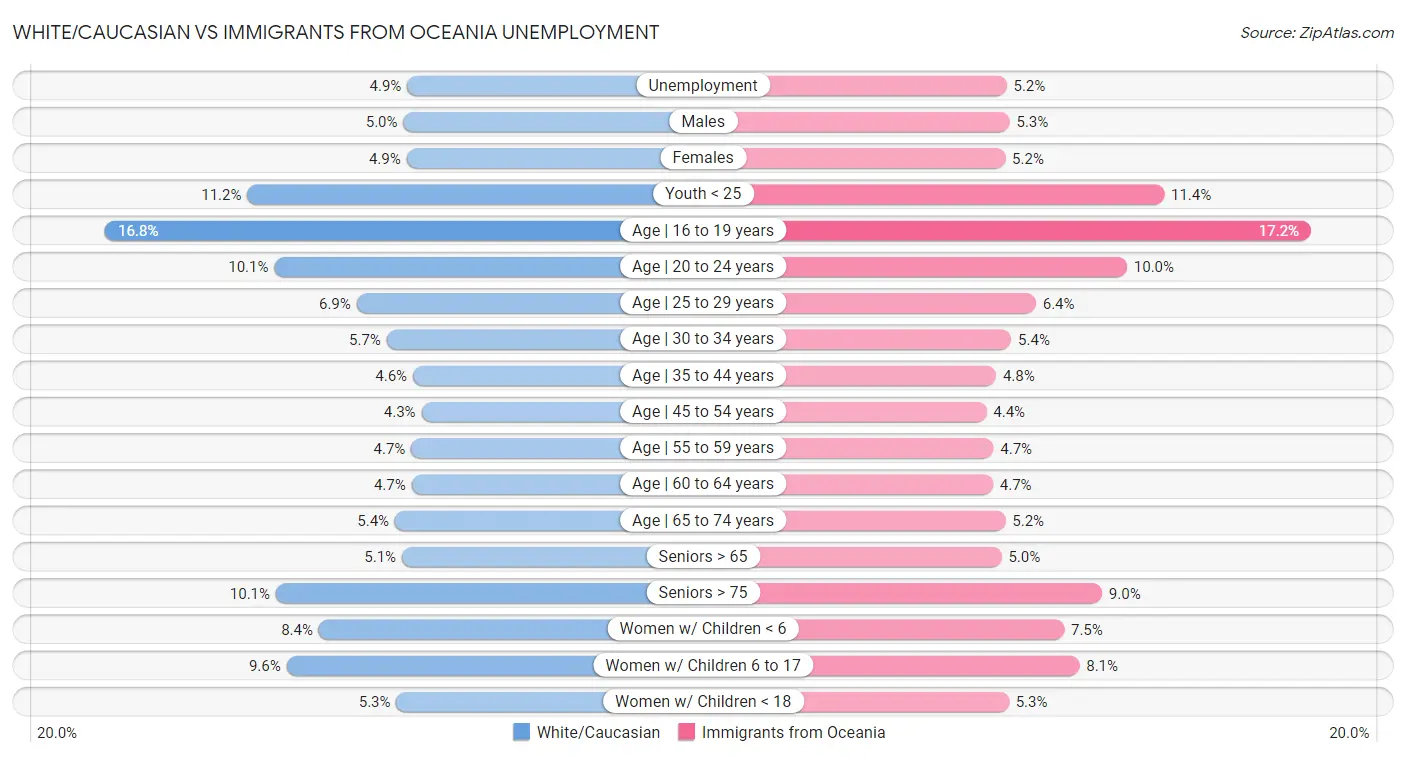
| Unemployment Metric | White/Caucasian | Immigrants from Oceania |
| Unemployment | Exceptional 4.9% | Good 5.2% |
| Males | Exceptional 5.0% | Average 5.3% |
| Females | Exceptional 4.9% | Good 5.2% |
| Youth < 25 | Exceptional 11.2% | Excellent 11.4% |
| Age | 16 to 19 years | Exceptional 16.8% | Excellent 17.2% |
| Age | 20 to 24 years | Excellent 10.1% | Exceptional 10.0% |
| Age | 25 to 29 years | Poor 6.9% | Exceptional 6.4% |
| Age | 30 to 34 years | Tragic 5.7% | Good 5.4% |
| Age | 35 to 44 years | Good 4.6% | Fair 4.8% |
| Age | 45 to 54 years | Exceptional 4.3% | Excellent 4.4% |
| Age | 55 to 59 years | Exceptional 4.7% | Exceptional 4.7% |
| Age | 60 to 64 years | Exceptional 4.7% | Exceptional 4.7% |
| Age | 65 to 74 years | Average 5.4% | Exceptional 5.2% |
| Seniors > 65 | Excellent 5.1% | Exceptional 5.0% |
| Seniors > 75 | Tragic 10.1% | Poor 9.0% |
| Women w/ Children < 6 | Tragic 8.4% | Good 7.5% |
| Women w/ Children 6 to 17 | Tragic 9.6% | Exceptional 8.1% |
| Women w/ Children < 18 | Excellent 5.3% | Excellent 5.3% |
White/Caucasian vs Immigrants from Oceania Labor Participation
When considering labor participation, the most significant differences between White/Caucasian and Immigrants from Oceania communities in the United States are seen in in labor force | age 16-19 (41.3% compared to 37.9%, a difference of 9.0%), in labor force | age > 16 (63.6% compared to 65.5%, a difference of 3.0%), and in labor force | age 20-24 (76.9% compared to 76.1%, a difference of 1.1%). Conversely, both communities are more comparable in terms of in labor force | age 25-29 (84.2% compared to 84.2%, a difference of 0.0%), in labor force | age 30-34 (83.9% compared to 84.0%, a difference of 0.15%), and in labor force | age 35-44 (83.6% compared to 83.9%, a difference of 0.28%).

| Labor Participation Metric | White/Caucasian | Immigrants from Oceania |
| In Labor Force | Age > 16 | Tragic 63.6% | Excellent 65.5% |
| In Labor Force | Age 20-64 | Tragic 78.5% | Poor 79.3% |
| In Labor Force | Age 16-19 | Exceptional 41.3% | Exceptional 37.9% |
| In Labor Force | Age 20-24 | Exceptional 76.9% | Exceptional 76.1% |
| In Labor Force | Age 25-29 | Tragic 84.2% | Tragic 84.2% |
| In Labor Force | Age 30-34 | Tragic 83.9% | Tragic 84.0% |
| In Labor Force | Age 35-44 | Tragic 83.6% | Tragic 83.9% |
| In Labor Force | Age 45-54 | Tragic 81.9% | Tragic 82.1% |
White/Caucasian vs Immigrants from Oceania Family Structure
When considering family structure, the most significant differences between White/Caucasian and Immigrants from Oceania communities in the United States are seen in births to unmarried women (33.3% compared to 30.6%, a difference of 8.8%), divorced or separated (12.6% compared to 11.9%, a difference of 5.8%), and average family size (3.14 compared to 3.29, a difference of 4.7%). Conversely, both communities are more comparable in terms of family households (65.1% compared to 64.9%, a difference of 0.27%), family households with children (27.4% compared to 28.1%, a difference of 2.4%), and single father households (2.4% compared to 2.5%, a difference of 2.8%).

| Family Structure Metric | White/Caucasian | Immigrants from Oceania |
| Family Households | Exceptional 65.1% | Exceptional 64.9% |
| Family Households with Children | Average 27.4% | Exceptional 28.1% |
| Married-couple Households | Exceptional 48.6% | Good 46.9% |
| Average Family Size | Tragic 3.14 | Exceptional 3.29 |
| Single Father Households | Fair 2.4% | Tragic 2.5% |
| Single Mother Households | Good 6.1% | Average 6.3% |
| Currently Married | Exceptional 48.6% | Average 46.5% |
| Divorced or Separated | Tragic 12.6% | Good 11.9% |
| Births to Unmarried Women | Poor 33.3% | Excellent 30.6% |
White/Caucasian vs Immigrants from Oceania Vehicle Availability
When considering vehicle availability, the most significant differences between White/Caucasian and Immigrants from Oceania communities in the United States are seen in no vehicles in household (7.0% compared to 9.7%, a difference of 38.3%), 2 or more vehicles in household (60.8% compared to 57.5%, a difference of 5.7%), and 4 or more vehicles in household (7.4% compared to 7.6%, a difference of 3.6%). Conversely, both communities are more comparable in terms of 1 or more vehicles in household (93.1% compared to 90.4%, a difference of 3.0%), 3 or more vehicles in household (22.6% compared to 21.8%, a difference of 3.6%), and 4 or more vehicles in household (7.4% compared to 7.6%, a difference of 3.6%).

| Vehicle Availability Metric | White/Caucasian | Immigrants from Oceania |
| No Vehicles Available | Exceptional 7.0% | Excellent 9.7% |
| 1+ Vehicles Available | Exceptional 93.1% | Excellent 90.4% |
| 2+ Vehicles Available | Exceptional 60.8% | Exceptional 57.5% |
| 3+ Vehicles Available | Exceptional 22.6% | Exceptional 21.8% |
| 4+ Vehicles Available | Exceptional 7.4% | Exceptional 7.6% |
White/Caucasian vs Immigrants from Oceania Education Level
When considering education level, the most significant differences between White/Caucasian and Immigrants from Oceania communities in the United States are seen in no schooling completed (1.6% compared to 2.2%, a difference of 37.6%), professional degree (4.1% compared to 4.6%, a difference of 12.1%), and doctorate degree (1.8% compared to 1.9%, a difference of 8.7%). Conversely, both communities are more comparable in terms of nursery school (98.5% compared to 97.8%, a difference of 0.64%), kindergarten (98.4% compared to 97.8%, a difference of 0.65%), and 1st grade (98.4% compared to 97.8%, a difference of 0.66%).
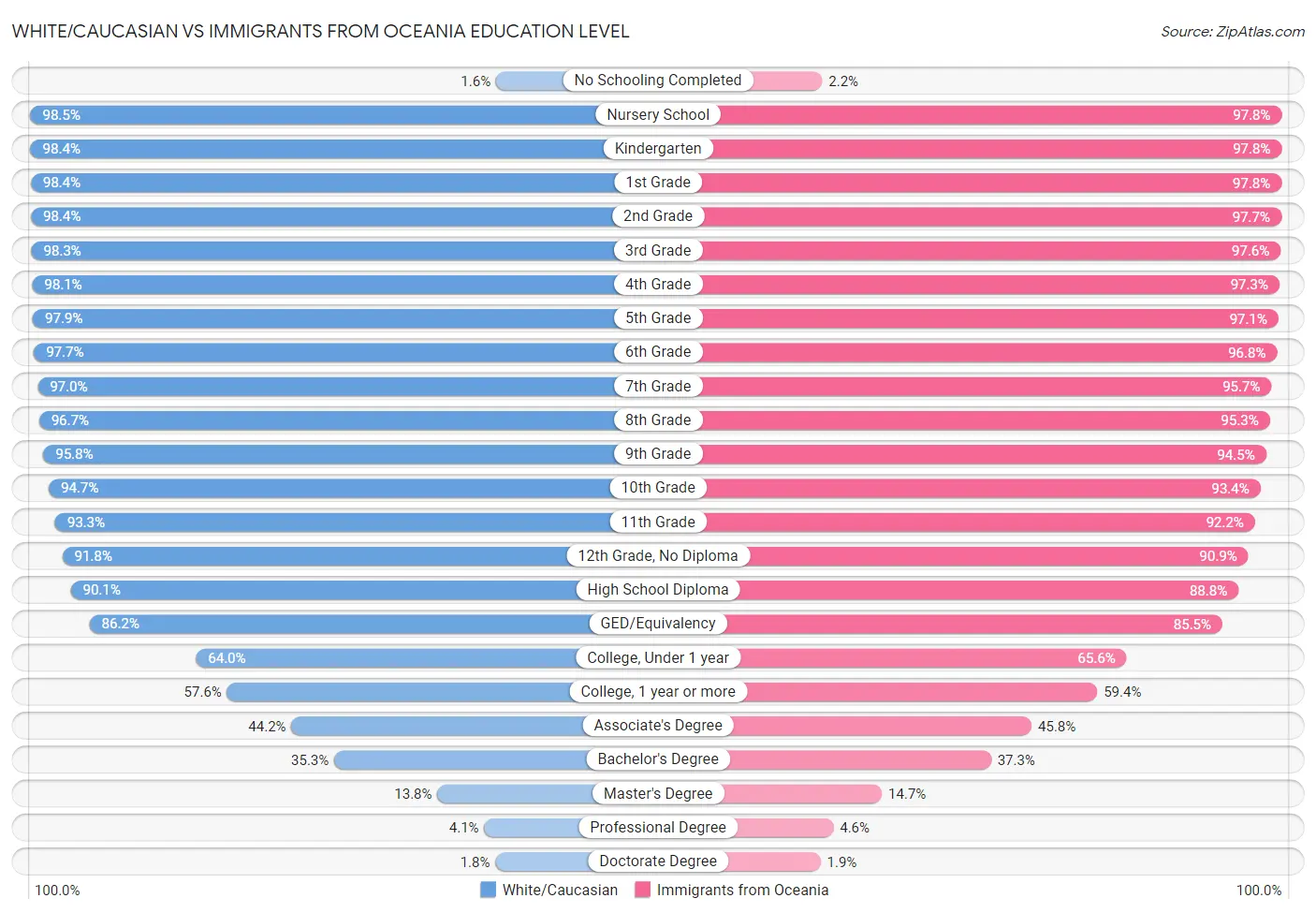
| Education Level Metric | White/Caucasian | Immigrants from Oceania |
| No Schooling Completed | Exceptional 1.6% | Poor 2.2% |
| Nursery School | Exceptional 98.5% | Poor 97.8% |
| Kindergarten | Exceptional 98.4% | Poor 97.8% |
| 1st Grade | Exceptional 98.4% | Poor 97.8% |
| 2nd Grade | Exceptional 98.4% | Poor 97.7% |
| 3rd Grade | Exceptional 98.3% | Tragic 97.6% |
| 4th Grade | Exceptional 98.1% | Tragic 97.3% |
| 5th Grade | Exceptional 97.9% | Poor 97.1% |
| 6th Grade | Exceptional 97.7% | Poor 96.8% |
| 7th Grade | Exceptional 97.0% | Tragic 95.7% |
| 8th Grade | Exceptional 96.7% | Tragic 95.3% |
| 9th Grade | Exceptional 95.8% | Poor 94.5% |
| 10th Grade | Exceptional 94.7% | Poor 93.4% |
| 11th Grade | Exceptional 93.3% | Fair 92.2% |
| 12th Grade, No Diploma | Exceptional 91.8% | Fair 90.9% |
| High School Diploma | Exceptional 90.1% | Fair 88.8% |
| GED/Equivalency | Good 86.2% | Fair 85.5% |
| College, Under 1 year | Poor 64.0% | Average 65.6% |
| College, 1 year or more | Tragic 57.6% | Average 59.4% |
| Associate's Degree | Tragic 44.2% | Fair 45.8% |
| Bachelor's Degree | Tragic 35.3% | Fair 37.3% |
| Master's Degree | Tragic 13.8% | Fair 14.7% |
| Professional Degree | Poor 4.1% | Good 4.6% |
| Doctorate Degree | Fair 1.8% | Good 1.9% |
White/Caucasian vs Immigrants from Oceania Disability
When considering disability, the most significant differences between White/Caucasian and Immigrants from Oceania communities in the United States are seen in disability age under 5 (1.7% compared to 1.2%, a difference of 42.9%), hearing disability (3.7% compared to 3.2%, a difference of 15.8%), and disability age 18 to 34 (7.6% compared to 6.7%, a difference of 14.5%). Conversely, both communities are more comparable in terms of disability age 65 to 74 (24.2% compared to 24.0%, a difference of 1.1%), disability age over 75 (47.3% compared to 48.0%, a difference of 1.4%), and self-care disability (2.6% compared to 2.5%, a difference of 2.5%).
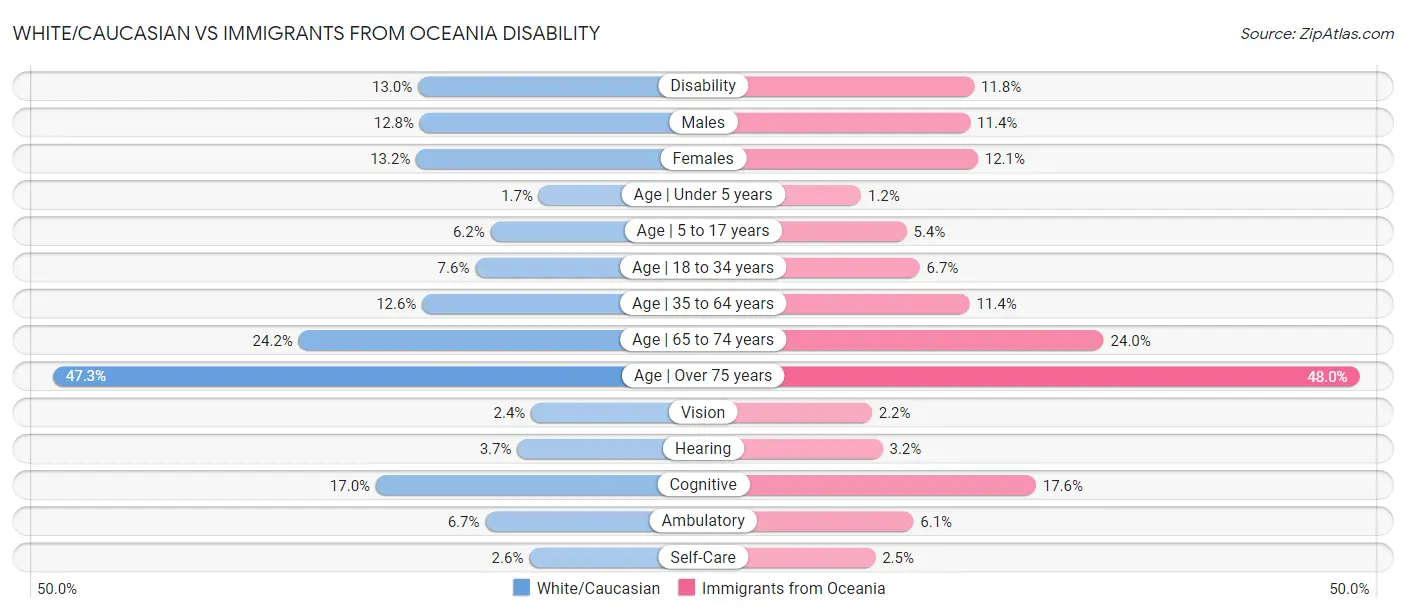
| Disability Metric | White/Caucasian | Immigrants from Oceania |
| Disability | Tragic 13.0% | Fair 11.8% |
| Males | Tragic 12.8% | Fair 11.4% |
| Females | Tragic 13.2% | Good 12.1% |
| Age | Under 5 years | Tragic 1.7% | Exceptional 1.2% |
| Age | 5 to 17 years | Tragic 6.2% | Exceptional 5.4% |
| Age | 18 to 34 years | Tragic 7.6% | Fair 6.7% |
| Age | 35 to 64 years | Tragic 12.6% | Fair 11.4% |
| Age | 65 to 74 years | Tragic 24.2% | Poor 24.0% |
| Age | Over 75 years | Average 47.3% | Tragic 48.0% |
| Vision | Tragic 2.4% | Average 2.2% |
| Hearing | Tragic 3.7% | Tragic 3.2% |
| Cognitive | Exceptional 17.0% | Tragic 17.6% |
| Ambulatory | Tragic 6.7% | Good 6.1% |
| Self-Care | Tragic 2.6% | Fair 2.5% |